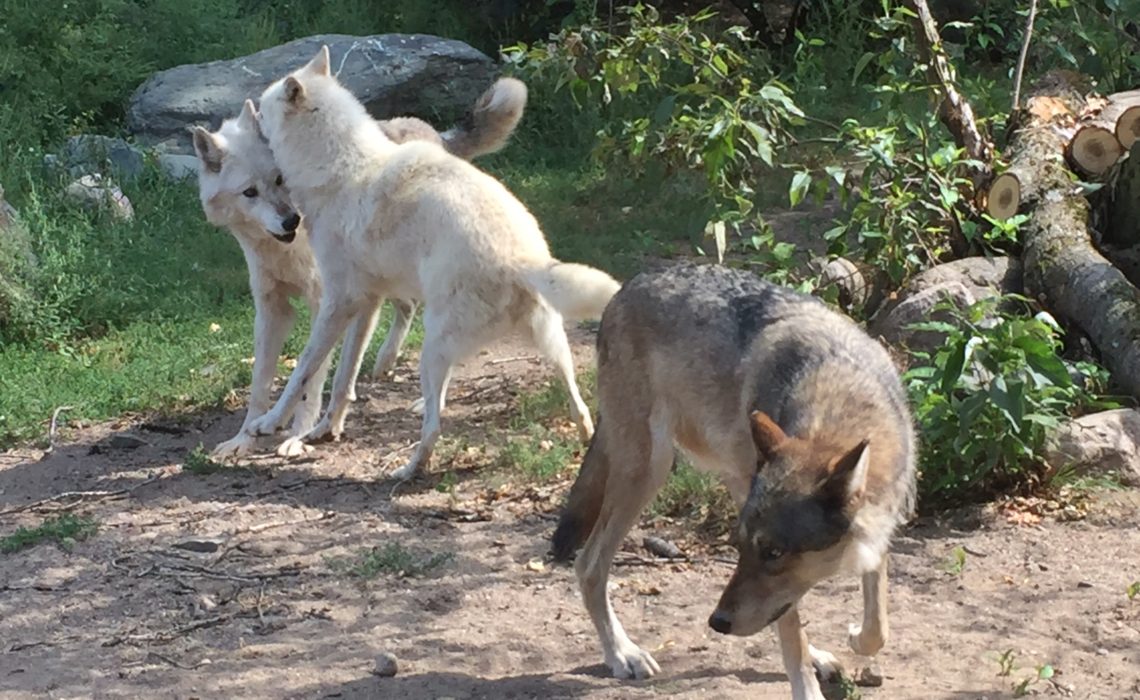
A branch of a tree rustles. A white paw appears. Then some gray ears. Before I know it, she is passing three feet in front of me. What I remember most is the long legs, the thick fur, and brown eyes. Then she begins to bark, and her three companions join in. They are howling, much like I envisioned, with their heads tipped back, as if they are singing to the Gods above. I get a few more moments watching these incredible creatures, and then they are gone.
I’m visiting northern Minnesota with my husband, and we have made a road trip up to Ely to the International Wolf Center. I get to spend time watching four wolves that are part of their outdoor exhibit area. The staff has lured them from their forested hiding places by playing audio sounds of wolves howling, barking and making other wolf-like noises. After a few minutes, these sounds that mimic wolves in the wild bring them down so they are right in front of the windows. Though I know they are captive, it is thrilling nonetheless.
But the Wolf Center is so much more than that. Exhibits explain wolves in depth — their behavior (why do they howl?), their physical traits, their relationship with moose. I even understand how dogs have evolved from wolves, and that a dog’s skeleton is not so much different. The relationship of wild wolves and people is explored, and myths are busted. In fact, I learn that no healthy wild wolf has ever killed a person in North America. I’m also surprised that in fact, the percentage of livestock killed by wolves is tiny.
My education about wolves leads me to reflect more about my home state of Colorado. Wolves became extinct almost a hundred years ago in the Rocky Mountain state. And since then, we’ve had an explosion of the elk population. So much so, that Rocky Mountain National Park currently culls elk in the winter time to curb the numbers. Boulder County allowed hunting at Rabbit Mountain last fall to reduce the herds.
If we’re already killing elk because the population is unnaturally high, why not reintroduce predators that would do the job for us? Wolves naturally prey on hoofed mammals like elk, deer and moose. Other national parks like Yellowstone have already gone forward and been successful with a reintroduction of the gray wolf.
The excuses I’ve frequently heard don’t jibe with the statistics. Some say if you brought wolves back into Rocky Mountain National Park, wolves would prey on kids in Estes Park. And yet, that’s what the data says. Even when it comes to livestock, they are more the exception than the rule.
The truth is that the wolves may be coming whether we like it or not. There have already been documented examples of wolves from Wyoming making their way into Colorado. So far, they have been lone wolves who were killed by automobiles or wandered back north of the border. But wolves can range hundreds of miles in search of food, so like it or not, it may be just a matter of time before they start showing up in the Centennial state.
Wouldn’t it be better to embrace their return and implement it in a planned and logical way than to just ignore the idea and live in denial?


What a great experience. We visited the CO Wolf & Wildlife Center in Divide a few years ago. Unforgettable. I am all for returning the wolf to Colorado but I worry about hunters and ranchers killing them. You know they will.